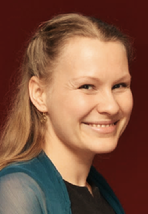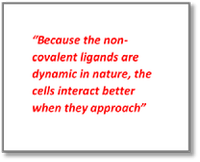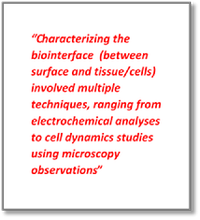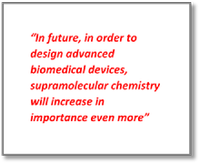 In this thesis strategies to anchor bioactive ligands, employing supramolecular host-guest chemistry, are presented and discussed. Creating biomimetic materials with tailored cellular responses upon engaging with cells, is a core challenge in biomaterials, medical devices and tissue regenerative medicine.
In this thesis strategies to anchor bioactive ligands, employing supramolecular host-guest chemistry, are presented and discussed. Creating biomimetic materials with tailored cellular responses upon engaging with cells, is a core challenge in biomaterials, medical devices and tissue regenerative medicine.
‘Towards the end of the project we achieved good results using non-covalently anchored ligands,’ says Jenny Brinkmann. ‘The dynamics better resemble natural protein behaviour. Here we observed different cell adhesion temporal dynamics.’
Cell machinery is enormously complex, with precisely regulated cues present in space and time. Fine tuning the spacing between artificial bioactive cues on surfaces, has shown to be a crucial design criterion for cells that interact with materials.
Non-covalent interactions

By adding dynamicity and control over temporal positioning of ligands stimuli-responsive surfaces of biomaterials and devices open up new opportunities, to steer cellular fate and study cellular mechanisms. As supramolecular host-guest interactions are in itself dynamic in nature - due to non-covalent interactions between molecules - make them highly attractive, for the exploration of cell-interactive surfaces in biological applications.
‘In short one could say: because the non-covalent ligands are dynamic in nature, the cells interact better when they approach,’ Jenny Brinkmann explains. ‘A second aspect in this PhD work, was to induce electrochemical stimulus, to trigger detachment. We strived towards a suitable platform for performing in vitro cell studies.’
Interdisciplinary

The type of work Jenny Brinkmann performed at the Molecular Nanofabrication group was highly multidisciplinary in nature. A fair amount of experimental techniques was involved,’ she says. ‘Characterizing the biointerface (between surface and tissue/cells) involved multiple techniques, ranging from electrochemical analyses to cell dynamics studies using microscopy observations.’

Cleanroom facilities were used for fabricating patterned chip architectures and for engineering the platforms. Monolayers of gold were used to attach biological assays to. Also gene-expression processes were studied. ‘In biomedical engineering all these aspects are of vital importance, making the field even the more interesting,’ says Brinkmann. ‘In future, in order to design advanced biomedical devices, supramolecular chemistry will increase in importance even more.’
Open culture
This PhD project was performed jointly with the Tissue Regeneration group and in close collaboration with the Chemical Biology group at The Technical University of Eindhoven. Also collaborations with other Mesa+ groups and cleanroom experts from Twente University were well represented.
‘After initially feeling overwhelmed at times, I really learned to appreciate the open Dutch culture,’ Jenny Brinkmann says. ‘The very direct responses I got, have been extremely helpful to my research, and on a personal level have contributed to confidently discuss any matters openly, without fear of personal criticism.’
Future research

Because of the positive results Jenny will be working as a post-doc the month following her PhD defence, to complete some final experiments and finish some publications.
‘I am glad my research work will be continued,’ she says. ‘Personally, I hope to continue working on designing promising biomaterials and their interaction with cells, for future generations of medicine. I believe this will be in an industrial working environment. In classical academics I am afraid lab-work will be under pressure even more in the years to come. The struggle for subsidies will take a lot of time. My preference is to see and study the phenomena actually happening under the microscope.’
